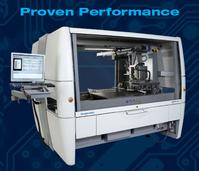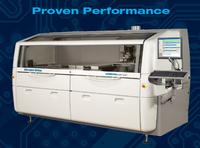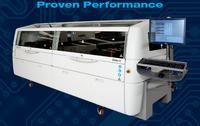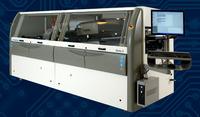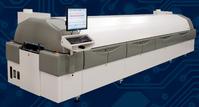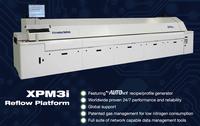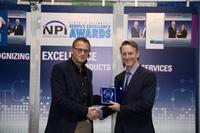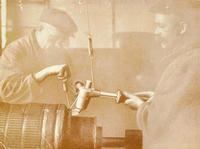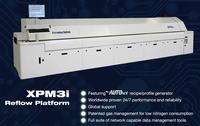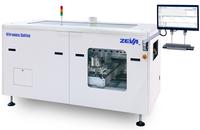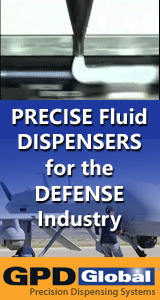Vitronics Soltec

Global manufacturer of XPM Reflow Ovens, ZEVA Selective Soldering and Delta Wave Soldering Equipment.
Vitronics Soltec is specialized in the design and manufacturing of mass soldering equipment for the global circuit board assembly market. Products are covering the Reflow, Wave and Selective Soldering markets. Vitronics Soltec is designing and manufacturing equipment in three factories; Camdenton MO in the USA, Oosterhout in The Netherlands and Suzhou in China. Direct sales and support centers are located in the United States, Holland, Germany, Singapore, Malaysia, Korea and Shanghai.
Vitronics Soltec was founded in 1916 and was one of the early pioneers in the field of industrial soldering. Innovations in those early days included the first electrical soldering iron. With the introduction of the circuit board in the fifties, electronics manufacturers needed a more time efficient method of soldering and the first Wave Soldering System was brought to the market. The introduction of mass soldering methods to the emerging electronics industry, laid the foundation for a future of innovative soldering equipment developments that is successfully continued today.
Vitronics Soltec Postings
7 products »
mySelective 6748 Selective Soldering System
The Vitronics Soltec mySelective 6748 brings a new dimension to selective soldering technology. It offers the ability to solder each joint under its optimum process parameters. The machine’s architecture allows it to assume...
mySelective 6747 Selective Soldering System
The Vitronics Soltec mySelective 6747 selective soldering automation workcell is ideal for soldering tall bottom side components, delivers great results as an alternative for pin-in-paste, and is perfect for safeg...
mySelective 6746 Selective Soldering System
The Vitronics Soltec mySelective 6746 is a selective soldering automation workcell that has been optimized for maximum throughput and flexibility while minimizing its footprint in the factory. Inline processes and...
Vitronics Soltec’s Delta platform has evolved over generations of equipment, with thousands of machines operating worldwide. The Delta 5 represents our latest wave soldering solution, featuring easy setup and operation and is the most rel...
Simplified design and easy operation make Delta 3 a high-reliability favorite. EasyUse, Delta 3’s user-friendly operator interface, displays alarms and setpoint values where they occur, making it simpler to prevent in-process problems....
The Vitronics Soltec MR+ product platform offers exceptional thermal transfer, temperature control accuracy, and cooling. The two models of MR+ contain over 10 patents including a gas recirculation system that...
The Vitronics Soltec XPM3 product platform is the latest evolution in a long history of reflow systems that have proven their capability worldwide and established a reputation for superior reliability. Robust design...
9 technical articles »
Selective soldering in an optimized nitrogen atmosphere
Nov 14, 2023 | Gerjan Diepstraten
In PCB circuit assemblies the trend is moving to more SMD components with finer pitch connections. The majority of the assemblies still have a small amount of through hole (THT) components. Some of them can't withstand high reflow temperatures, while others are there because of their mechanical robustness. In automotive applications these THT components are also present. Many products for cars, including steering units, radio and navigation, and air compressors also use THT technology to connect board-to-board, PCB's to metal shields or housings out of plastic or even aluminium. This is not a simple 2D plain soldering technology, as it requires handling, efficient thermal heating and handling of heavy (up to 10 kg) parts. Soldering technology becomes more 3D where connections have to be made on different levels. For this technology robots using solder wire fail because of the spattering of the flux in the wires and the long cycle time. In wave soldering using pallets the wave height is limited and pin in paste reflow is only a 2D application with space limitations....
Selective soldering in an optimized nitrogen atmosphere
Sep 29, 2021 | Gerjan Diepstraten
In PCB circuit assemblies the trend is moving to more SMD components with finer pitch connections. The majority of the assemblies still have a small amount of through hole (THT) components. Some of them can't withstand high reflow temperatures, while others are there because of their mechanical robustness. In automotive applications these THT components are also present. Many products for cars, including steering units, radio and navigation, and air compressors also use THT technology to connect board-to-board, PCB's to metal shields or housings out of plastic or even aluminium. This is not a simple 2D plain soldering technology, as it requires handling, efficient thermal heating and handling of heavy (up to 10 kg) parts. Soldering technology becomes more 3D where connections have to be made on different levels. For this technology robots using solder wire fail because of the spattering of the flux in the wires and the long cycle time. In wave soldering using pallets the wave height is limited and pin in paste reflow is only a 2D application with space limitations. Selective soldering using dedicated plates with nozzles on the solder area is the preferred way to make these connections. All joints can be soldered in one dip resulting in short cycle times. Additional soldering on a small select nozzle can make the system even more flexible. The soldering can only be successful when there is enough thermal heat in the assembly before the solder touches the board. A forced convection preheat is a must for many applications to bring enough heat into the metal and board materials. The challenge in a dip soldering process is to get a sufficient hole fill without bridging and minimize the number of solder balls. A new cover was designed to improve the nitrogen environment. Reducing oxygen levels benefits the wetting, but increases the risk for solder balling. Previous investigations showed that solder balling can be minimized by selecting proper materials for solder resist and flux....
How to Manage Material Outgassing in Reflow Oven
Nov 24, 2020 | Gerjan Diepstraten
In a lead-free reflow process, temperatures are higher, and materials use outgasses more than in a leaded reflow process. The trends toward higher density populated boards and more pin-in-paste technology also increase solder paste use. More components and more solder paste result in more outgassing of chemistry during the reflow process. Some assemblies report condensation of vapors when the cold printed circuit board enters the oven. Little is known about the interaction between these condensed materials in terms of the interaction between these condensed materials and the reliability of the assembly. Apart from the question of reliability, a printed circuit board contaminated with a small film of residues after reflow soldering is not desirable....
Reduce Pollution of Process Gasses in an Air Reflow Oven
Jul 02, 2019 | Gerjan Diepstraten
The introduction of lead-free solders resulted in a selection of different chemistries for solder pastes. The higher melting points of lead-free alloys required thermal heat resistant rosin systems and activators that are active at elevated temperatures. As a result, more frequent maintenance of the filtration systems is required and machine downtime is increased.</p><p>Last year a different method of cleaning reflow ovens was introduced. Instead of cooling down the process gasses to condensate the residues, a catalyst was used to maintain the clean oven. Catalytic thermal oxidation of residues in the nitrogen atmosphere resulted in cleaner heating zones. The residues were transformed into carbon dioxide. This remaining small amount of char was collected in the catalyst. In air ovens the catalyst was not seen as a beneficial option because the air extracted out of the oven was immediately exhausted into the environment. When a catalyst is used in an air environment there is not only the carbon dioxide residues, but also water. When a catalyst is used in an air reflow oven the question is where the water is going to. Will it condensate in the process part of the oven or is the gas temperature high enough to keep it out of the process area? A major benefit of using a catalyst to clean the air before it is exhausted into the environment is that the air pollution is reduced dramatically. This will make environmental engineers happy and result in less pollution of our nature. Apart from this, the exhaust tubes remain clean which reduces the maintenance of air ovens.</p><p>This paper will give more detailed information of catalyst systems during development and performance in production lines....
Design Rules For Selective Soldering Assemblies
Feb 14, 2018 | Vitronics Soltec Oosterhout
This document describes general guidelines and attention points for PCB design regarding selective soldering. The guidelines can be applied for Select Wave and/or Multi Wave soldering process in both leaded and leadfree alloy. When a PCB is designed according to these guidelines, a stable and solid solder-process can be guaranteed....
Effective Methods to Get Volatile Compounds Out of Reflow Process
Feb 11, 2016 | Gerjan Diepstraten
Although reflow ovens may not have been dramatically changed during the last decade the reflow process changes step by step. With the introduction of lead-free soldering not only operation temperatures increased, but also the chemistry of the solder paste was modified to meet the higher thermal requirements. Miniaturization is a second factor that impacts the reflow process. The density on the assembly is increasing where solder paste deposit volumes decreases due to smaller pad and component dimensions. Pick and place machines can handle more components and to meet this high through put some SMD lines are equipped with dual lane conveyors, doubling solder paste consumption. With the introduction of pin in paste to solder through hole components contamination of the oven increased due to dripping of the paste....
Position Accuracy Machines for Selective Soldering Fine Pitch Components
Feb 27, 2015 | Gerjan Diepstraten
The drive towards fine pitch technology also affects the soldering processes. Selective soldering is a reliable soldering process for THT (through hole) connectors and offers a wide process window for designers. THT connectors can be soldered on the top and bottom side of boards, board in board, PCBs to metal shields or housing out of plastic or aluminum are today's state of the art. The materials that are used to make the solder connections require higher temperatures. Due to the introduction of lead-free alloys, the boards need more heat to get the barrels filled with solder. This not only affects the properties of the flux and components, but the operation temperatures of solder machines become higher (...)
First the impact of temperature will be discussed for the separate process steps and for machine tooling. In the experimental part measurements are done to verify the accuracy that can be achieved using today's selective soldering machines. Dedicated tooling is designed to achieve special requirements with respect to component position accuracy....
Quieting the Noise: Quality Wave Soldering Depends on Control of Its Many Parameters.
Jan 24, 2008 | Gerjan Diepstraten, Senior Process Engineer, Vitronics Soltec BV
The wave solder process is characterized by a large number of process parameters. To understand them all and their interactions is challenging, particularly when it comes to lead-free soldering. Wave soldering has a number of sub-processes, which include fluxing, preheating, soldering and cooling....
Lead-free Wave Soldering of Simple to Highly Complex Boards. Process Optimization
Jan 10, 2008 | Denis Barbini, Vitronics Soltec; Paul Wang, Microsoft; Peter Biocca, ITW Kester; Quyen Chu, Jabil
This research takes an in-depth look at the challenges encountered in developing a lead free wave soldering process based on the specific products as well as on specific materials. It attempts to provide the reader with the information necessary to make educated decisions in selecting materials and controlling various process parameters in order to execute a rational implementation strategy for a reliable and robust lead free wave soldering process....
12 news releases »
![]() Jun 20, 2017 | ITW EAE, the Electronic Assembly Equipment division of Illinois Tool Works, announces a new partnership agreement with DiversiTech to represent and distribute Vitronics Soltec soldering equipment for the territory of Southern California, Southern Nevada and Baja, Mexico. This agreement is an expansion of DiversiTech’s representation of ITW EAE’s product line which already included MPM printers, Camalot dispensers, and Electrovert soldering and cleaning equipment.
Jun 20, 2017 | ITW EAE, the Electronic Assembly Equipment division of Illinois Tool Works, announces a new partnership agreement with DiversiTech to represent and distribute Vitronics Soltec soldering equipment for the territory of Southern California, Southern Nevada and Baja, Mexico. This agreement is an expansion of DiversiTech’s representation of ITW EAE’s product line which already included MPM printers, Camalot dispensers, and Electrovert soldering and cleaning equipment.
![]() May 01, 2017 | ITW EAE’s Vitronics Soltec earned two coveted VA Excellent Awards from the SMT China Vision Awards at the recent NEPCON China exposition and conference in Shanghai. The CATHOX™ Catalytic Thermal Oxidizer was recognized in the Reflow Soldering category and the ZEVAm took the prize in the Selective Soldering category.
May 01, 2017 | ITW EAE’s Vitronics Soltec earned two coveted VA Excellent Awards from the SMT China Vision Awards at the recent NEPCON China exposition and conference in Shanghai. The CATHOX™ Catalytic Thermal Oxidizer was recognized in the Reflow Soldering category and the ZEVAm took the prize in the Selective Soldering category.
Vitronics Soltec Receives Award for Catalytic Thermal Oxidizer Technology in Reflow Soldering System
![]() Feb 28, 2017 | ITW EAE’s Vitronics Soltec was honored with a New Product Introduction award during the IPC APEX Expo at the San Diego Convention Center. The award, presented by Circuits Assembly and Printed Circuit Design and Fab, was in recognition of the CATHOX™ Catalytic Thermal Oxidizer used in the Centurion Reflow Soldering System. An independent panel of practicing industry engineers selected the recipients for this 10th annual award for electronics assembly equipment, materials, software, and PCB fabrication.
Feb 28, 2017 | ITW EAE’s Vitronics Soltec was honored with a New Product Introduction award during the IPC APEX Expo at the San Diego Convention Center. The award, presented by Circuits Assembly and Printed Circuit Design and Fab, was in recognition of the CATHOX™ Catalytic Thermal Oxidizer used in the Centurion Reflow Soldering System. An independent panel of practicing industry engineers selected the recipients for this 10th annual award for electronics assembly equipment, materials, software, and PCB fabrication.
Vitronics Soltec Receives Award for Catalytic Thermal Oxidizer Technology in Reflow Soldering System
![]() Feb 21, 2017 | ITW EAE’s Vitronics Soltec was honored with a New Product Introduction award during the IPC APEX Expo at the San Diego Convention Center. The award, presented by Circuits Assembly and Printed Circuit Design and Fab, was in recognition of the CATHOX™ Catalytic Thermal Oxidizer used in the Centurion Reflow Soldering System. An independent panel of practicing industry engineers selected the recipients for this 10th annual award for electronics assembly equipment, materials, software, and PCB fabrication.
Feb 21, 2017 | ITW EAE’s Vitronics Soltec was honored with a New Product Introduction award during the IPC APEX Expo at the San Diego Convention Center. The award, presented by Circuits Assembly and Printed Circuit Design and Fab, was in recognition of the CATHOX™ Catalytic Thermal Oxidizer used in the Centurion Reflow Soldering System. An independent panel of practicing industry engineers selected the recipients for this 10th annual award for electronics assembly equipment, materials, software, and PCB fabrication.
Vitronics Soltec: 100th Anniversary
![]() Jun 05, 2016 | Vitronics Soltec celebrates 100 years of innovation and service to the soldering and printed circuit board industry.
Jun 05, 2016 | Vitronics Soltec celebrates 100 years of innovation and service to the soldering and printed circuit board industry.
![]() Mar 07, 2016 | Four Vitronics Soltec XPM3 Reflow Soldering Systems were recently purchased and installed at Inovar, Inc., a full-service EMS provider. The reflow ovens currently are in use at Inovar on its three production lines as well as its prototype line.
Mar 07, 2016 | Four Vitronics Soltec XPM3 Reflow Soldering Systems were recently purchased and installed at Inovar, Inc., a full-service EMS provider. The reflow ovens currently are in use at Inovar on its three production lines as well as its prototype line.
Vitronics Soltec to Launch ZEVAm Selective Soldering Platform at Productronica 2015
![]() Oct 29, 2015 | Vitronics Soltec will formally introduce their new ZEVAm Selective Soldering platform in Vitronics Soltec’s booth (Hall A4, Booth 554) at Productronica in Munich, Germany, November 10-12 2015. ZEVAm is a flexible, high-performing and affordable point-to-point soldering system offering a stunning array of process and productivity-enhancing features that bring value and flexibility to today’s selective soldering process.
Oct 29, 2015 | Vitronics Soltec will formally introduce their new ZEVAm Selective Soldering platform in Vitronics Soltec’s booth (Hall A4, Booth 554) at Productronica in Munich, Germany, November 10-12 2015. ZEVAm is a flexible, high-performing and affordable point-to-point soldering system offering a stunning array of process and productivity-enhancing features that bring value and flexibility to today’s selective soldering process.
Vitronics Soltec USA to Introduce New YouTube Channel at IPC APEX 2012
![]() Feb 22, 2012 | Vitronics Soltec USA will introduce its new YouTube channel at their booth (3509) at the IPC APEX 2012 trade show in San Diego, CA. The new channel will initially feature several animations that highlight key features and functions of each of Vitronics Soltec's three soldering machine types: wave, selective, and reflow.
Feb 22, 2012 | Vitronics Soltec USA will introduce its new YouTube channel at their booth (3509) at the IPC APEX 2012 trade show in San Diego, CA. The new channel will initially feature several animations that highlight key features and functions of each of Vitronics Soltec's three soldering machine types: wave, selective, and reflow.
Vitronics Soltec USA Moves to New Headquarters
![]() Aug 01, 2011 | Vitronics Soltec USA has announced it is moving to its new corporate headquarters effective August 1, 2011.
Aug 01, 2011 | Vitronics Soltec USA has announced it is moving to its new corporate headquarters effective August 1, 2011.
Vitronics Soltec USA Moving Manufacturing of Reflow and Selective Soldering Machinery
![]() Apr 22, 2011 | Vitronics Soltec USA will transition production of the XPM Reflow product line to its sister company’s location in Camdenton, Missouri, and will move production of Selective machinery to Vitronics Soltec's European manufacturing facility in Oosterhout, the Netherlands. The company will complete this transition by August 1, 2011.
Apr 22, 2011 | Vitronics Soltec USA will transition production of the XPM Reflow product line to its sister company’s location in Camdenton, Missouri, and will move production of Selective machinery to Vitronics Soltec's European manufacturing facility in Oosterhout, the Netherlands. The company will complete this transition by August 1, 2011.
